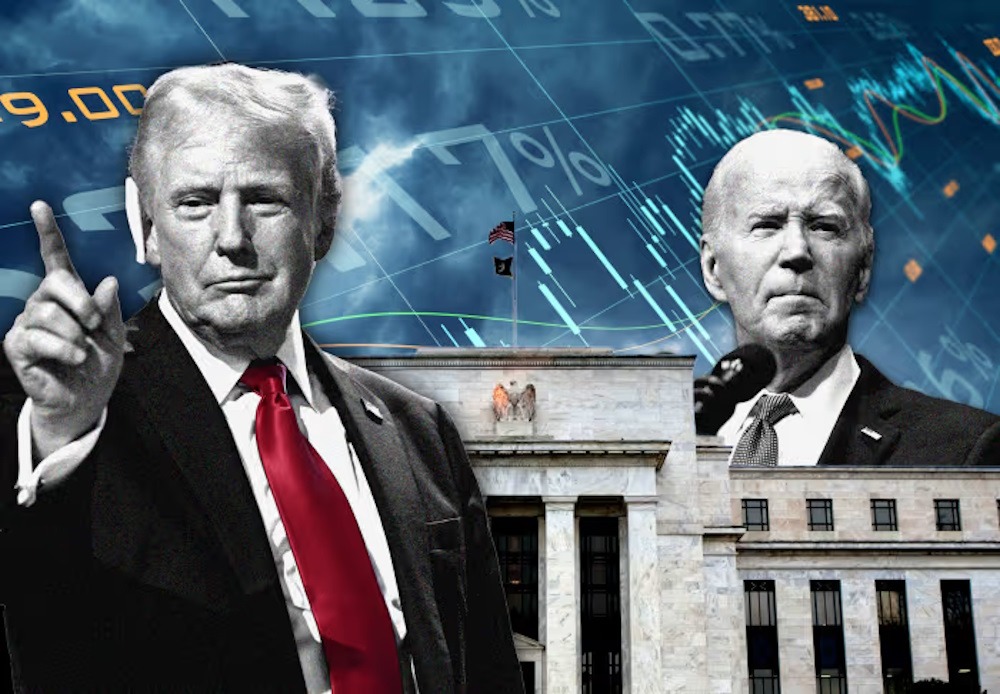Trump trade has made a comeback

The Trump trade has made a comeback. But was it ever successful? Given the prevalence of themes and memes in financial markets, investors have a clear strategy for trading in the event of a potential Donald Trump presidency. One often overlooked question is whether this playbook truly proves effective.
Until late last week, 2024 was dominated by the emergence of large corporations connected to artificial intelligence. Suddenly, the Russell 2000 index of small-capitalization stocks experienced a significant shift, going from a relatively stable performance year-to-date to a remarkable 10% increase. On Wednesday, it achieved its most impressive weekly outperformance ever against the Russell 1000, which comprises larger firms. Simultaneously, the Nasdaq, which is heavily influenced by technology stocks, experienced its most significant single-day drop in percentage since December 2022. This occurred despite the recovery of more affordable “value” stocks.
The recent fluctuations on Thursday and Friday partially offset the overall trend observed in the past week and a half, which bears similarities to the market response following Trump’s unexpected win in the 2016 presidential election. Wall Street had expected that concerns over a more protectionist agenda would trigger a decline in the stock market. Instead, the expectation of tax cuts sparked a rally. A new era of economic strategy emerged.
The fundamental principles remain unchanged. Invest in stocks. Shift focus towards smaller, domestically focused companies and traditional industries, while reducing support for tech giants. By selling bonds and buying the dollar, one can potentially address a higher budget deficit and lower immigration. Consider selling the Mexican peso.
Indeed, the most recent rotation was initially sparked by a positive inflation report, causing markets to anticipate additional interest rate reductions throughout the year. This is the reason behind the downward trend in Treasury yields and the weakening of the U.S. dollar.
However, the fact that Trump has managed to survive an assassination attempt and is gaining a significant lead in the polls has also had a substantial impact.
The Mexican peso has experienced significant volatility, reaching its highest level since 2020. Consider the challenges faced by international markets, despite the typically favorable conditions for them during periods when investors favor value stocks. Eurozone equities experienced a brief surge on July 12, but have since failed to meet expectations. Within the domestic market, certain sectors such as energy, manufacturing, and finance have experienced notable success. Regional banks, in particular, stand to benefit from reduced regulatory scrutiny and higher interest rates.
One potential issue, though, is that trades made in 2016 may not be applicable or logical in 2024.
It is evident that there are clear factors at play here: Trump’s recent shift in attitude towards cryptocurrencies has resulted in a significant surge in the value of bitcoin. However, deciphering other changes can be more challenging: Trump has garnered backing from Tesla CEO Elon Musk and has selected JD Vance, who has ties to Silicon Valley billionaires, as his running mate.
Given the potential impact of a Republican presidency on aid for electric-vehicle makers like Tesla, as well as the protection they may receive from Chinese manufacturers, the overall outcome remains uncertain. It seems that retail trading in Tesla shares has increased, with a similar number of investors selling as buying, as reported by flow analytics firm VandaTrack.
In a similar vein, Big Tech stands to gain if a Trump administration fails to match the antitrust fervor of the Biden one. Oil-and-gas majors may face a potential downside to the benefits of reduced environmental barriers due to a surplus in production.
The 2016 pop was driven by certain significant changes that cannot be replicated. The budget deficit has significantly increased compared to previous years, while the Tax Cuts and Jobs Act of 2017 reduced the top rate on corporate tax from 35% to 21%. According to an economic perspective, Trump’s proposal to further reduce it would only bring it down to 20%. His proposed tariff increases could potentially have a greater impact compared to eight years ago. This is because President Biden has maintained most of the protectionist measures he inherited and even introduced additional ones.
Furthermore, it is uncertain whether the initial attempt at the Trump trade proved successful for investors. In 2018, the stock market experienced a boost due to the tax cuts. However, the majority of the net-income gains were concentrated among the largest companies, with the tech sector being one of the main beneficiaries.
The Russell 2000’s strong performance following the 2016 election was not sustained for long. Small-cap stocks had a disappointing performance during Trump’s four-year tenure, despite a brief revival in 2018. Industrials, energy, and banks all performed worse than the S&P 500, while the dollar and Treasury yields finished lower. Ultimately, the most favorable trade during the Trump era turned out to be in the technology sector.
It can be quite challenging to profit from elections, primarily due to the dominance of secular forces over political agendas. Experienced investors may have the opportunity to benefit from the popular Trump trade, but it’s important to distinguish between a trade and a strategy.



